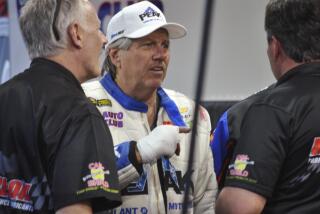Ryan Newman released from hospital two days after horrific Daytona 500 crash
- Share via
Less than two days after being in a horrific accident on the last lap of the Daytona 500, driver Ryan Newman was released from the hospital Wednesday.
Roush Fenway Racing announced the Newman had been treated and released from Halifax Medical Center in Daytona Beach and tweeted a picture of him walking on his own power, holding his daughters’ hands.
The extent of his injuries has not been disclosed.
It’s the remarkable end to a story that started on Monday night when NASCAR and its fans held their collective breaths after an accident that was shocking for its sheer violence and intensity. The post-race celebration and news conference with winner Denny Hamlin was somber as many feared the sport had suffered its first fatality in nearly two decades.
Earlier on Wednesday, the race team issued an update that said: “The veteran driver is fully alert and walking around Halifax Medical Center. True to his jovial nature, he has also been joking around with staff, friends and family while spending time with his two daughters.”
The announcement came shortly after Newman’s wife, Krissie, posted a picture on Twitter of Newman in a hospital gown, standing and smiling with his two daughters in front of him.
On Friday, Krissie Newman had announced on Twitter that she and her husband were separating after 16 years of marriage. She said they would jointly raise their daughters and remained friends.
The accident on Monday occurred as Newman and Hamlin were both going for the lead when Ryan Blaney pushed the back of Newman’s car, a legal move. The cars locked bumpers, sending Newman into the wall and into the air. When the car landed, it was hit on the driver’s side by Corey LaJoie, sending the car onto its roof. It slid along the track, creating sparks and a fire.
Safety workers took several minutes to extricate Newman from the car before he was rushed to the hospital.
Newman’s fast recovery is a testament to safety measures put in place by NASCAR after the death of Dale Earnhardt in 2001. The cars are reinforced with roll bars, the drivers wear head-and-neck restraint devices, and fire-retardant materials are used.
Earnhardt died when the impact of hitting the wall caused his head to lurch forward, fracturing his skull and severing the arteries in his neck. Between May 2000 and February 2001, four drivers died on the track — Adam Petty, Kenny Irwin, Tony Roper and Earnhardt.
More to Read
Go beyond the scoreboard
Get the latest on L.A.'s teams in the daily Sports Report newsletter.
You may occasionally receive promotional content from the Los Angeles Times.











